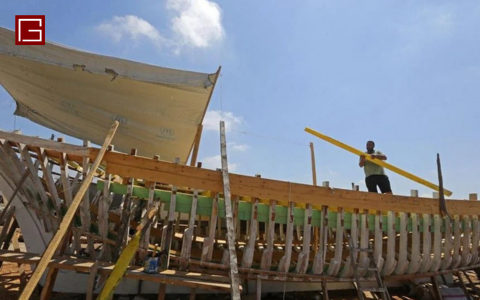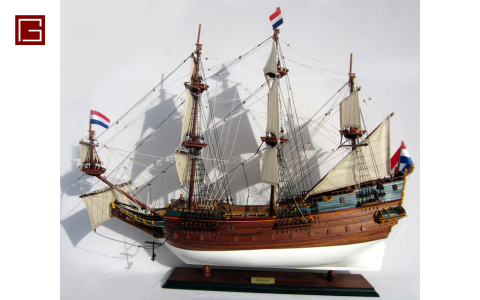BLog New
How Ancient Shipwrights Crafted Vessels to Withstand Tempests
CONTENTS
- 1 Monsoon Season – A Life-and-Death Test on the Open Sea
- 2 Traditional Shipbuilding Secrets for Surviving Storms
- 3 Ancient Ships That Weathered the Storm – Testaments of Enduring Craftsmanship
- 4 A Legacy Preserved in Handcrafted Wooden Models
- 5 Handcrafted Ship Models – Preserving the Maritime Legacy Through Time
Monsoon Season – A Life-and-Death Test on the Open Sea
Each year, storm seasons sweep across major oceans such as the East Sea, the Atlantic, and the Indian Ocean—bringing fierce winds, towering waves, and treacherous currents. For ancient sailors navigating in handcrafted wooden vessels, these tempests were inescapable and often deadly.
Yet, without modern meteorological tools or steel-clad hulls, ancient shipbuilders developed exceptional techniques to help vessels endure the fury of nature. These time-honored methods not only safeguarded lives and cargo but also laid the foundation for centuries of seafaring resilience—many of which are still reflected in the wooden ship models crafted today.
Traditional Shipbuilding Secrets for Surviving Storms
Below are the key shipbuilding strategies used by ancient craftsmen to enhance safety and stability during storm season—many of which are exquisitely preserved in today’s handcrafted wooden ship replicas:
1. Curved Hulls with Streamlined, Slender Forms
Ancient ships were designed with crescent-shaped, curved hulls that minimized wave resistance and deflected impact force. This curvature allowed ships to better maintain balance under repeated wave assaults. Both the bow and stern were elevated higher than the midsection, allowing water to drain more easily from the deck during storms.
2. Durable, Water-Resistant Natural Wood
Shipbuilders of old selected dense, high-quality hardwoods such as teak, ironwood, or golden oak—known for their strength, resistance to water damage, and longevity in humid, storm-prone conditions. To enhance waterproofing, the hull was often coated with natural oil or tar (bitumen), which also helped deter insects and fungi.

3. Robust Joinery – Precision-Crafted Mortise and Tenon Construction
Rather than relying on nails as in modern shipbuilding, ancient craftsmen used intricate mortise and tenon joints secured with wooden pegs. This interlocking system enhanced structural flexibility and load-bearing capacity, preventing breakage under the intense stress of storm-driven waves.
4. Adaptable and Controllable Sail Systems
Sails were made from canvas or heavy-duty fabric, allowing them to be reefed or adjusted to redirect forceful winds and avoid capsizing. Some ancient vessels featured auxiliary sails—used to increase thrust in calm seas and reduce wind exposure during storms.
5. Seamanship and Ocean Wisdom
Beyond technical design, ancient sailors relied heavily on their observational skills—reading clouds, waves, wind direction, and seabird behavior to anticipate approaching storms. These intuitive methods often enabled crews to take shelter or prepare their vessel before the worst hit—saving both lives and cargo on extended voyages.
Ancient Ships That Weathered the Storm – Testaments of Enduring Craftsmanship
Maritime history is rich with legendary vessels that survived ferocious storms, standing as symbols of resilience and exceptional shipbuilding artistry.
One iconic example is the Mayflower, which carried English pilgrims to America in 1620. Over its 66-day Atlantic crossing, the Mayflower endured violent autumn gales that sank many lesser vessels. Yet thanks to its strong hull and maneuverable rigging, the ship arrived safely—securing its place in history as a maritime triumph.
Similarly, the Batavia, part of the Dutch East India Company’s fleet, became renowned for weathering multiple fierce storms in the Indian Ocean and Red Sea. Though it eventually wrecked on a coral reef, its design represented the pinnacle of 17th-century Dutch naval engineering—able to withstand months-long voyages under extreme conditions.
A Legacy Preserved in Handcrafted Wooden Models
These real-life storm-defying voyages are not only feats of navigation but also enduring sources of inspiration. Today’s handcrafted wooden ship models faithfully capture the spirit and structure of these historic vessels—not just as decorative art, but as tributes to human courage and ingenuity at sea.

From Storm-Tossed Voyages to Timeless Craft – The Soul of Ancient Ship Models
It is precisely these true stories of ships braving tempests that give handcrafted model ships their unique value. Today’s traditional sailing ship models are more than ornamental pieces—they embody the heroic spirit of ancient seafarers, capturing the adventurous soul and enduring will to conquer the oceans.
Handcrafted Ship Models – Preserving the Maritime Legacy Through Time
At Gia Nhien, each handcrafted model ship is a tribute to the golden age of maritime history. Painstakingly made from natural hardwood, these models reflect the refined artistry and technical accuracy of historical vessels. From the curved hulls and canvas sails to intricate rudders and rigging, every detail is recreated with devotion.
Featured models include:
-
Dutch tall ships, known for their trade expeditions and storm-resistant design
-
European warships, symbols of power and naval mastery
-
Ancient Chinese merchant junks, which once ruled the seas of Asia
More than just collectibles, each model tells a tale—of battles survived, oceans crossed, and ingenuity tested. These vessels inspire modern-day collectors and ocean lovers, reminding us of the courage, resilience, and brilliance of early maritime explorers.
We hope this article has satisfied your curiosity about the fascinating world of ships. If you’re inspired by these engineering marvels and want to bring a piece of that maritime magic into your own space, don’t hesitate to visit the Gia Nhien’s showroom. With a collection of over 1,000 handcrafted wooden ship and boat models, each piece is meticulously made from natural wood by skilled artisans, capturing the elegance, detail, and heritage of real vessels.
These exquisite models are not only a celebration of fine craftsmanship but also the perfect addition to elevate your home or office decor with a touch of nautical charm.
👉 Explore the full collection of model ships here: https://woodenmodelships.net/shop/
And don’t forget to follow the Gia Nhien Wooden Ship Models Blog for more captivating stories and knowledge from the maritime world!

